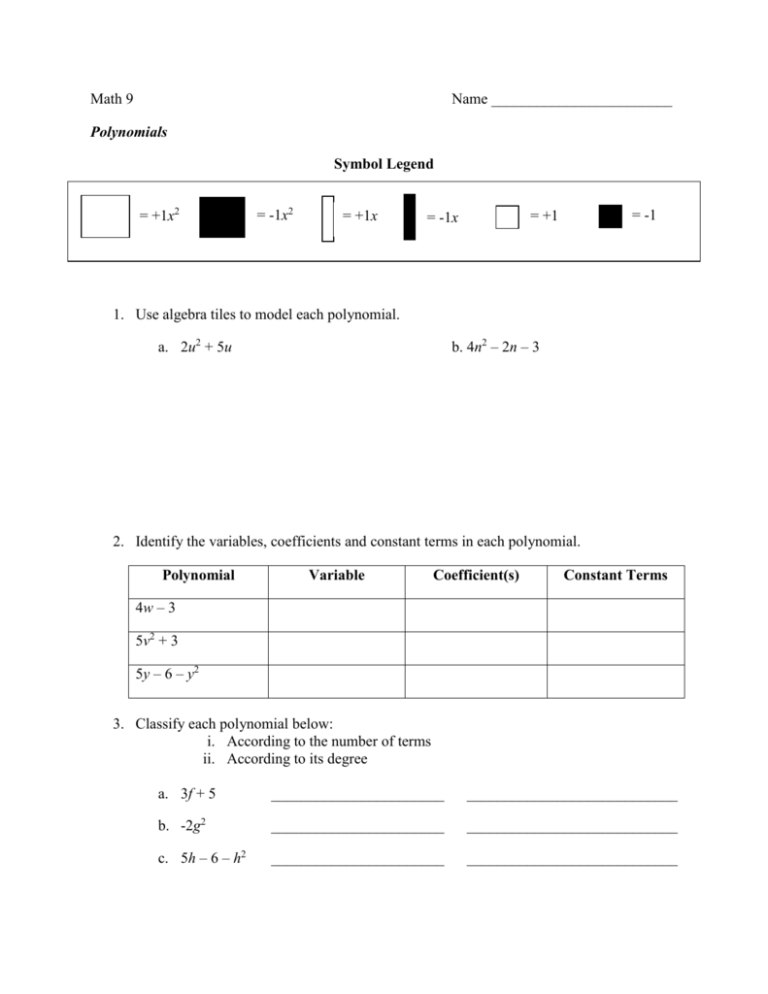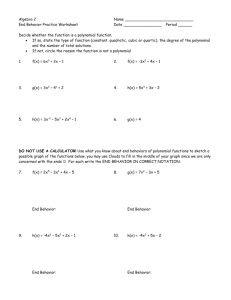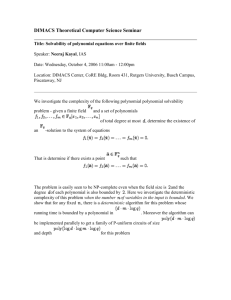File
advertisement

Math 9 Name ________________________ Polynomials Symbol Legend = +1x2 = -1x2 = +1x = -1 = +1 = -1x 1. Use algebra tiles to model each polynomial. b. 4n2 – 2n – 3 a. 2u2 + 5u 2. Identify the variables, coefficients and constant terms in each polynomial. Polynomial Variable Coefficient(s) Constant Terms 4w – 3 5v2 + 3 5y – 6 – y2 3. Classify each polynomial below: i. According to the number of terms ii. According to its degree a. 3f + 5 _______________________ ____________________________ b. -2g2 _______________________ ____________________________ c. 5h – 6 – h2 _______________________ ____________________________ 4. Use algebra tiles to model the polynomial that fits each description. Sketch the tiles you used. a. A second-degree trinomial in the variable y, the coefficients of the variable when the polynomial is written in descending order are -1 and -3 and with a constant term 4. b. A first-degree binomial in the variable x, with constant term 4, and the coefficient of the other term is -3. 5. Identify the equivalent polynomials. a. –3x2 + 3x – 11 b. 3x2 + 4x c. – 2 – x d. 7 + 5x e. 5x + 7 f. x – 2 g. 4x + 3x2 h. 3x – 11 – 3x2 6. Which polynomial is modeled by each set of algebra tiles? State the degree of the polynomial. a. Polynomial ______________________ Degree ______ Polynomial ______________________ Degree ______ b. Polynomial ______________________ Degree ______ 7. Jennie does not understand how the terms 2k and k2 are different. Use algebra tiles to model these terms and explain the difference. 8. Identify like terms. a. 5x2, 3y2, – 2x2, 5x, 2y b. -8x, 5x, 8, –2, –x, 11 9. Simplify by combining like terms. a. 3x + 4 – 2x – 8 + 3x – 3 b. 4y2 – 2y + 3y – 11y2 c. 2a2 + 7a – 3 – 2a2 – 4a + 6 d. 2a2 + 3a + 3a2 – a2 – a – 4a2 10. Match each algebra tile model below with its corresponding polynomial. a. n2 – n + 3 b. –w2 – 3 c. –2t d. 2q + 2 e. 2r2 – 2r A. Corresponding polynomial _____ B. Corresponding polynomial _____ C. Corresponding polynomial _____ D. Corresponding polynomial _____ E. Corresponding polynomial _____ 11. Add or subtract as indicated. a. ( p 2 3 p 5) (3 p 2 p 1) b. (3q 2 3q 7) (2q 2 q 2) c. (6 3r 7r 2 ) (9 4r 3r 2 ) d. (5s 3 s 2 ) (5 3s 2s 2 ) e. (4t 2 3t 9) (2t 2 5t 1) f. (9u 2 5) (3u 2 9) g. (3a 2 5ab 7b2 ) (3b2 10ab 7a 2 ) h. (10 xy 3 y 2 2 x) (5 y 4 x 2 xy) 12. The sum of two polynomials is 15c + 6. One polynomial is 3c – 7. What is the other polynomial? 13. Match each sum or difference of polynomials with its answer. A (5x2 – 2) + (2x2 + 4) P 4x2 + 2x – 1 B (x2 – 3x) – (4x2 – x) Q 7x2 + 2 C (x2 + 2x + 3) + (3x2 – 4) R x2 +2x – 1 D (3x2 – x + 2) – (2x2 – 3x + 3) S –3x2 – 2x E (–3x – 2) – (3x – 2) T –6x 14. Write a polynomial for the perimeter of each shape. Simplify the polynomial. Determine each perimeter when a = 3cm. a. A 3a + 5 2a b. A 5a + 7 15. Determine each product or quotient. a. 10k ÷ 2 b. 5(–4x2) c. 2(–3m + 4) d. 6n 2 3 e. 3(4 s 1) f. 9 12m 3 g. 5( 7 2 x) h. 2(1 2n 3n2 ) i. 2( x 3x 2 ) j. (6 p 2 6 p 4) (2) k. 15 21q 6q 2 3 l. (2 5n 7n2 )(6) m. ( xy x 2 y 2 )(2) n. (12m2 6n 8m) (2) o. 18 pq 3 p 2 9q 3 p. 4(2r 2 3r 4s 5s 2 ) 16. Determine each product. a. (7s)(2s) b. (-3g)(-5g) c. m(3m + 2) d. -5t(t – 3) e. 7z(–4z – 1) f. (–3f – 5)( –2f) g. –5k(3 – k) h. y(1 – y) 17. This diagram shows one rectangle inside another. 6x 4x 2x a. Determine the area of each rectangle. b. Determine the area of the shaded region. 3x 18. Determine each quotient. a. 24 j (6 j ) b. 24 x 3x c. 36 x 2 9 x d. (8a 2 12a) 4a e. (8c 4c 2 ) 4c f. 19. 14 y 2 21y 7 y a. The area of a rectangular deck is (8d2 + 20d) square meters. The deck is 4d meters long. Determine a polynomial that represents the width of the deck. b. What are the dimensions and area of the deck when d is 4 meters?







